News & Announcements
- Details
- Written by Joshua Wachtel
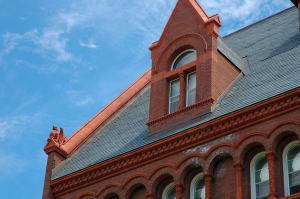 Photo by Tim Plante - from Flickr Creative CommonsTo conclude the series this week of posts about Building Campus Community, IIRP's newest project dealing with applying Restorative Practices in residential life departments at colleges and universities, I'll conclude with a short passage from Chapter 5, Responsive Restorative Circles, from the new book.
Photo by Tim Plante - from Flickr Creative CommonsTo conclude the series this week of posts about Building Campus Community, IIRP's newest project dealing with applying Restorative Practices in residential life departments at colleges and universities, I'll conclude with a short passage from Chapter 5, Responsive Restorative Circles, from the new book.
For more information about this project, visit the Building Campus Community web site. Note, too, that there will be webinars on this topic offered on February 23, March 19 and April 3.
- Details
- Written by Joshua Wachtel
Today's offering is, again, a sample from the Building Campus Community book. This passage is from Chapter 4, Proactive Community Circles:
Creative Ways to Engage Residents in Proactive Community Circles
While supervisors will most likely provide RAs with topic ideas and guidelines about how frequently to hold community circles with residents, experience shows that flexibility is really important, too. RAs who adapt circles to suit their personalities, their residents’ needs and attributes, the unique circumstances of each living situation and the common space available for meetings tend to have the best success.
- Details
- Written by Joshua Wachtel
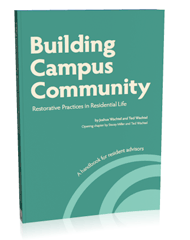 IIRP now has a brand new book, Building Campus Community: Restorative Practices in Residential Life. I co-wrote the book with Ted Wachtel, and the introductory chapter was co-written by Stacey Miller, University of Vermont Director of Residential Life, and Ted Wachtel.
IIRP now has a brand new book, Building Campus Community: Restorative Practices in Residential Life. I co-wrote the book with Ted Wachtel, and the introductory chapter was co-written by Stacey Miller, University of Vermont Director of Residential Life, and Ted Wachtel.
Here are a couple excepts from Chapter 3 discussing the special role of the RA and how Restorative Practices can help balance the ideals of being a community leader with the need to also enforce behavioral norms:
- Details
- Written by Joshua Wachtel
This week I'll be featuring different links related to IIRP's newest project, Building Campus Community. This project helps campuses apply the full spectrum of restorative practices at the college and university level, beginning specifically with residence halls. Restorative practices gives resident advisors (RA's) a wide range of tools for both building community proactively and responding to harm and wrongdoing when it occurs.
By way of introduction, here are two videos from administrators and RA's at the University of Vermont, a campus currently in its second year of RP implementation for residence halls across the entire campus.
- Details
- Written by Joshua Wachtel
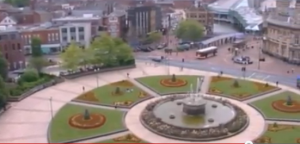 This piece was written by John Macdonald discussing Hull, UK's project to become the world's first restorative city by implementing restorative practices throughout the city for public service agencies working with youth, including schools and police. He makes the case that private business would do well to examine restorative practices as a leadership model. The article first appeared under the title "Restoring Your Bottom Line: Restorative Practices in the Business Environment."
This piece was written by John Macdonald discussing Hull, UK's project to become the world's first restorative city by implementing restorative practices throughout the city for public service agencies working with youth, including schools and police. He makes the case that private business would do well to examine restorative practices as a leadership model. The article first appeared under the title "Restoring Your Bottom Line: Restorative Practices in the Business Environment."
IIRP has worked extensively with Hull, conducting trainings and offering materials that Hull uses for its trainings. Read more about Hull's efforts to become a restorative city here.
- Details
- Written by Joshua Wachtel
March 6 & 7, 2012, 8:30 AM – 4:00 PM
Hosted by: Lancaster Catholic High School, 650 Juliette Avenue, Lancaster, PA
Two in-service days offered in the SaferSanerSchools Whole-School Change Program
Introduction to Restorative Practices — $140 Tuesday, March 6, 2012 — Register here.
Ideally paired with Using Circles Effectively
- Details
- Written by Joshua Wachtel
Last week I linked to a blog post by Photographer Matt Roth about City Springs Elementary/Middle School in Baltimore and their successful use of Restorative Practices for dealing with safety issues. Today I'm reposting a piece about the Baltimore Curriculum Project, which discusses the history and context of their adoption of Restorative Practices. The original post can be found here.
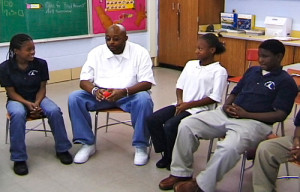 In the fall of 2005 Baltimore Curriculum Project (BCP) President Muriel Berkeley attended a workshop at the Maryland Charter School Network Conference that sparked a wholesale transformation of school culture at BCP's four neighborhood charter schools: City Springs School, Collington Square School of the Arts, Hampstead Hill Academy, and Wolfe Street Academy.
In the fall of 2005 Baltimore Curriculum Project (BCP) President Muriel Berkeley attended a workshop at the Maryland Charter School Network Conference that sparked a wholesale transformation of school culture at BCP's four neighborhood charter schools: City Springs School, Collington Square School of the Arts, Hampstead Hill Academy, and Wolfe Street Academy.
- Details
- Written by Joshua Wachtel
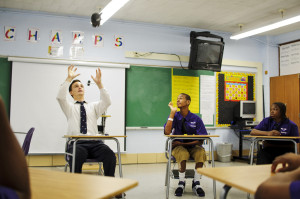 Photographer Matt Roth posted some lovely photos recently on his blog, part of a photo shoot for an article that appeared in Education Week last summer.
Photographer Matt Roth posted some lovely photos recently on his blog, part of a photo shoot for an article that appeared in Education Week last summer.
The quote that stands out for me is this one, a candid impression of what it felt like to spend time in City Springs Elementary/Middle School, a school that is part of the Baltimore Curriculum Project and with whom IIRP has worked extensively:
- Details
- Written by Joshua Wachtel
"We must also propose new ways of life ... that means shifting from a punitive mindset to a restorative one."
I'm working on a new eForum article about a program called FaithCARE which applies restorative practices to faith communities and congregations. I've recently had the opportunity to interview Mark Vander Vennen of Shalem Mental Health Network in Ontario, Canada about this project and to talk to Bruce Schenk of IIRP Canada again, who partners with Shalem and has been very active in developing the program.
So it was pleasant to see this piece by Mark which discusses the need for restorative responses in light of a "tough-on-crime" law currently moving its way through the Canadian legislature. I'm reposting the article below, but the original piece can be found in Northumberland Today by clicking here.
- Details
- Written by Samantha White
|
When challenging behavior:
|
To help those affected:
|
| Purchase packs of 100 "Restorative Questions Cards. |
|

Restorative Works Year in Review 2023 (PDF)
All our donors are acknowledged annually in Restorative Works.
